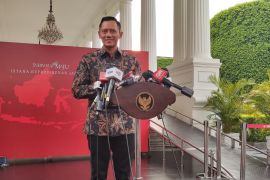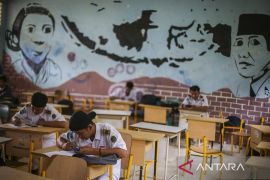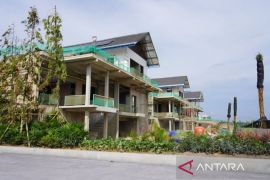Nusantara, which is located in East Kalimantan, is among the areas with the richest biodiversity in Indonesia. There are many species that are endemic to the area.
According to the records of the Nusantara Capital Authority (OIKN), there are 3,889 species that are indicated to be found within a 50-kilometer radius of the area, including mammals, birds, reptiles, amphibians, fish, plants, insects, and arachnids.
However, data from the International Union for Conservation of Nature (IUCN) indicates that 440 species, or 11.8 percent of the total identified species, are vulnerable, critical, or at risk of extinction, and thereby in need of conservation.
This cannot be separated from the environmental problems recorded before construction work began in Nusantara.
Deforestation due to illegal logging, forest fires, illegal mining, expansion of oil palm plantations, and forest encroachment have greatly changed Kalimantan's forests.
Satellite imagery released by the National Aeronautics and Space Administration (NASA) also shows clear evidence of depleting forest cover in the Nusantara area.
As per the satellite imagery, in April 2022, the forest cover in Nusantara was still dense, while in February 2024, the impact of forest clearing was visible in several areas.
Deputy for environment and natural resources at the OIKN, Myrna Safitri, noted that the condition of Nusantara's protected forests is far from ideal. Massive forest conversion in the last few decades -- way before Nusantara's construction started -- has changed its forests.
According to her, the secondary forest cover in Nusantara currently accounts for only 16 percent of the total 256,142 hectares of the new capital's area. Therefore, efforts are needed to restore at least 120 thousand hectares by 2045.
She affirmed that the development of Nusantara as a forest city will prioritize nature sustainability and biodiversity protection. Efforts to restore the ecosystem will also be made to revive Kalimantan's tropical forests.
One of the efforts has been the launch of the Biodiversity Management Plan, which will serve as a road map for Nusantara's development that continues to prioritize nature conservation and prevent the extinction of species in the new capital area.
The plan, which was launched on March 26, 2024, was created through discussions with experts, academics, local non-governmental organizations, and international institutions.
The document contains several key points regarding Nusantara's development and covers aspects such as preserving the forest ecosystem and the remaining wetlands, habitat preservation, species protection, and restoration efforts.
The plan will be implemented for five years — from 2024 to 2029.
Related news: OIKN turns to citizen science to protect biodiversity
Biodiversity in Nusantara
The OIKN has identified seven areas in Nusantara and its surrounding areas that have high biodiversity.
The areas include the Mount Beratus Landscape, Soeharto Hill Forest Park, Balikpapan Bay, Sungai Wain Protected Forest, Samboja Lestari (rehabilitation center), Muara Jawa sub-district, and Mount Parung.
The Wain River Protected Forest is a lowland forest spread over 10 thousand hectares within the Balikpapan administrative area, which borders Nusantara. The protected forest contains a primary forest surrounded by forests that have been slightly degraded due to forest fires in the past.
In the protected forest area, 42 types of mammals, 21 types of birds, and 4 types of reptiles were found from 2016 to 2022. They included the blue-headed pitta, black hornbill, bay cat, and sun bear.
Balikpapan Bay has a water surface of around 120 km with a maximum width of 7 km, and the coastline of the bay is mostly covered with mangroves. Balikpapan Bay is a habitat for estuarine crocodiles, green sea turtles, dugongs, and porpoises.
Meanwhile, Gunung Parung in the western part of Nusantara is a forest area that stretches from a production forest concession area to Meratus Mountains.
There are several protected species in the area, such as maroon leaf monkeys, brahminy kites, proboscis monkeys, and purple herons.
Soeharto Hill Forest Park, which stretches over an area of 64 hectares, is a conservation forest area in Nusantara. According to OIKN data, currently, the land cover consists of approximately 57 percent forested area, and the rest is used for illegal activities, such as plantations, mining, and buildings.
The Soeharto Hill Forest Park is a habitat for clouded leopards, rhinoceros hornbills, and grey gibbons.
Meanwhile, the animals that can be found in Muara Jawa, which was once a mangrove forest area, include proboscis monkeys and collared kingfishers.
Samboja Lestari, which spans 1,852 hectares, is a rehabilitation center for several species, such as orangutans and sun bears.
It is also home to Far Eastern curlews, Rhacophoridae, grey gibbons, and maroon leaf monkeys.
On account of the high value of biodiversity and existing challenges, the OIKN is working hard to realize sustainable development. To this end, several strategic steps have been prepared under the Biodiversity Management Master Plan.
To restore the ecological function of Kalimantan's forests, the director of forest and water resources utilization development at the OIKN, Pungky Widiaryanto, said that the authority will designate 65 percent of Nusantara's area as a protected area.
This will include 40 thousand hectares of secondary forests, 2 thousand hectares of mangrove forests, 55 thousand hectares of industrial/monoculture plantation forests, and 80 thousand hectares of agriculture, mining, and oil palm plantations.
Meanwhile, 25 percent of Nusantara's area has been earmarked for infrastructure development while the remaining 10 percent would be used for agricultural purposes.
Apart from restoring the ecological function of forests, harmony between humans and wildlife around the Nusantara area also needs to be paid attention to.
Widiaryanto affirmed that the OIKN has devised measures to prevent human-wildlife conflict in the new capital.
Related news: OIKN to build wildlife crossings to preserve biodiversity in Nusantara
Harmony with nature
Considering the natural habitats of wild animals in areas in and around Nusantara and the potential of their encountering humans, the OIKN is planning to build a buffer zone on the outskirts of the city.
The buffer zone will later be planted with certain trees that will serve as natural barriers that prevent wild animals from entering residential areas.
"This buffer can function to deter wild animals that have the potential to be in conflict with humans, so they do not enter the city," Widiaryanto informed.
OIKN is also paying attention to efforts to preserve wildlife habitats in the Nusantara area. One of the main concerns is ensuring that wild animals can cross the new capital area safely.
One of the measures to address this is a plan to build wildlife crossings, both underpasses and overpasses, which would help wild animals cross the Nusantara development area safely.
"We are identifying the paths that are presumably taken by animals. We will build artificial corridors that are adjusted to the animals' habitats," he informed.
As part of anticipatory measures against human-wildlife conflict, the OIKN, in cooperation with the Ministry of Environment and Forestry, will form a special team to handle such conflicts.
At the end of the day, the development of Nusantara as the new national capital is not only about building infrastructures and relocating the seat of government.
More than that, there is a dream of sustainable future development in Nusantara, which would not only aim to create a modern city, but also protect and manage the biodiversity around it.
Collaboration between the government, academicians, environmental activists, and the community is vital to monitor and ensure the implementation of biodiversity management plans in Nusantara's development.
Related news: OIKN outlines three clusters for Nusantara Forest City realization
Translator: Shofi Ayudiana, Raka Adji
Editor: Tia Mutiasari
Copyright © ANTARA 2024












